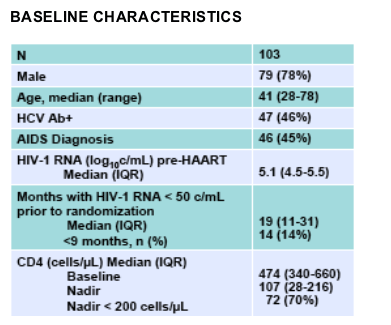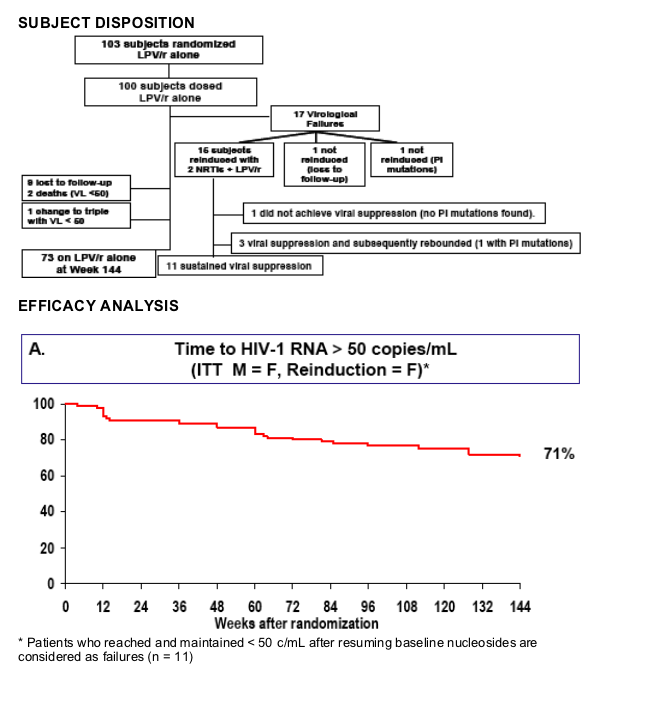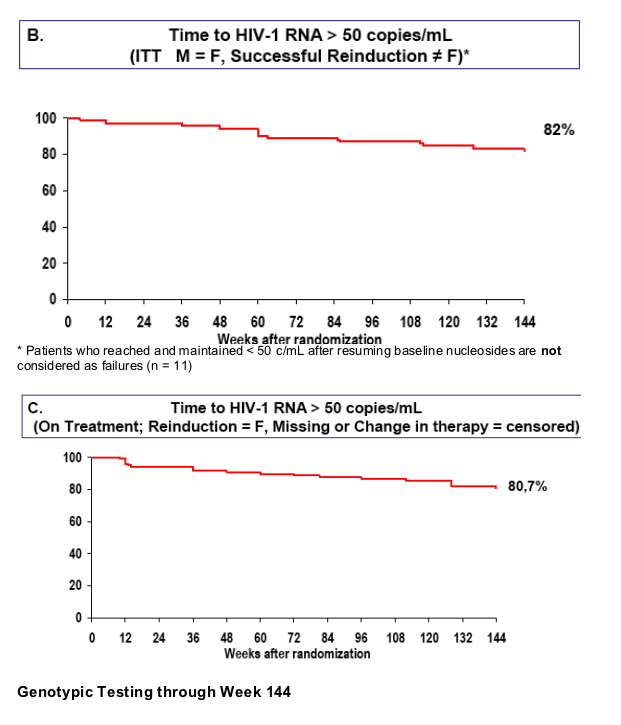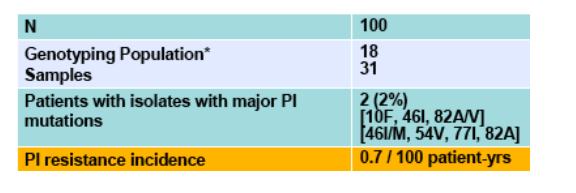 |
 |
 |
| |
Three-year Efficacy of Lopinavir/ritonavir Monotherapy in the OK04 Trial
|
| |
| |
Reported by Jules Levin
ICAAC/IDSA Oct 28 208 Wash DC
F. Pulido1, R. Delgado1, A. Arranz2, R. Rubio1, J. Pasquau3, A.Ocampo4, J. Portilla5, JR. Arribas6, and the OK04 Study Group
1Hospital 12 de Octubre, Madrid, Spain; 2Hospital Príncipe de Asturias, Alcalá de Henares, Madrid, Spain; 3Hospital Vírgen de las Nieves, Granada, Spain; 4Hospital Xeral_Cies, Vigo, Pontevedra, Spain; 5Hospital General de Alicante, Alicante, Spain and 6Hospital La Paz, Madrid, Spain.
AUTHOR DISCUSSION
After three years of follow up the OK-04 study shows that lopinavir/ritonavir monotherapy can maintain HIV viral suppression in a very large proportion of patients.
Of the 100 patients initially randomized to lopinavir/ritonavir monotherapy, 71% remain on monotherapy with an HIV viral load of less than 50 HIV-RNA copies/mL at week 144.
This result support the durability of lopinavir-ritonavir monotherapy and is consistent with the long term follow-up of our pilot clinical trial in which 66.7% of patients randomized to lopinavir-ritonavir monotherapy remain on monotherapy and with HIV RNA <50 copies/mL after four years of follow-up (J Antimicrob Chemother. 2008;61:1359-61)
AUTHOR CONCLUSION
Three year results of OK04 trial supports long term efficacy and a minimal risk
of resistance of the strategy lopinavir-ritonavir monotherapy with reintroduction
of nucleosides as needed
ABSTRACT
Background: The OK04 trial showed that 96-wks of lopinavir-ritonavir (LPV/r) monotherapy (MT) with reintroduction of nucleosides as needed was non-inferior to triple therapy (T) for maintenance of HIV suppression. After a 96 wk comparative phase, patients randomized to T switched to MT. We report final 144 wk data of patients originally randomized to MT.
Methods: Patients were eligible if they had no history of virological failure (VF) while receiving a protease inhibitor (PI), were receiving 2 nucs and LPV/r and had viral load (VL) <50 for > 6 months. Patients with confirmed VF (> 50 c/mL) while on LPV/r MT without genotypic resistance to LPV were re-intensified with nucs.
Results: Of the 100 patients originally randomized to MT, 71 (71%)* remain with VL <50 c/mL on MT (ITT, missing data and reinductions = Failure). Of the 18 patients (18%) who had VF during follow-up, 15 were reinduced with nucs. 2 patients with VF were not reinduced due to loss to follow-up. One patient with VF was not reinduced due to detection of PI mutations.
Outcomes after re-induction: 11 sustained viral suppression; 3 viral suppression and subsequently rebounded (1 with PI mutations); 1 did not achieve viral suppression (no PI mutations found). 9 patients on MT were lost to follow-up and 2 died while virologically suppressed. 1 patient on MT was switched to triple therapy while < 50 c/mL. From wk 48 to wk 144 resistance genotyping did not show new isolates with major PI mutations (PI resistance incidence: 0.7 / 100 patient-yr).
Conclusions: After 3 years most patients on LPV/r MT remain virologically suppressed. Incidence of PI resistance was very low. In patients with VF, reinduction with nucs was generally successful. This study supports the long term efficacy and safety of LPV/r MT for maintenance of HIV suppression.
[*This is a change from the printed abstract, as one additional patient with >50 c/mL at the time of the abstract submission regained <50 c/mL on monotherapy and he was re-classified as a blip (not VF)]

OBJECTIVE
To report final 144 wk data of patients originally randomized to MT in the OK04 trial
METHODS
· From week 96 to week 144 all patients were on Lopinavir/ritonavir tablets (by w96, switched from SGC).
· After week 96 all patients randomized to triple therapy were switched to monotherapy (results of this switch are not reported here)
· Based on the first year results, protocol was amended to allow intensification with nucleosides if patients developed HIV-RNA > 50 but < 500 c/mL that was confirmed in 3 other samples within the following 8 wks (During the first year intensification was per protocol performed only after confirmed HIV-RNA > 500 c/mL)
Efficacy analysis:
A. Time to HIV-1 RNA > 50 c/mL, ITT, Missing or Change in randomized therapy = Failure (TLOVR algorithm). In this analysis patients who reached and maintained < 50 c/mL after resuming baseline
nucleosides are considered as failures. (Most Conservative)
B. Time to HIV-1 RNA >50 c/mL ITT, Missing or Change in randomized therapy other than reinduction = Failure, Successful Reinduction ≠ Failure (Therapeutic Failure). In this analysis patients who reached and maintained < 50 c/mL after resuming baseline nucleosides are not considered as failures. (It explores efficacy of the strategy of monotherapy followed by reinduction with nucleosides if needed)
C. Time to HIV-1 RNA > 50 copies/mL , On Treatment, Reinduction = Failure, Missing or Change in therapy not due to virological failure = censored (It explores only virological failures of monotherapy)
· Visits: Screening, Baseline, Week 4 and 12, then every 12 weeks up to Week 96, and then every 16 weeks to Week144




|
| |
|
 |
 |
|
|